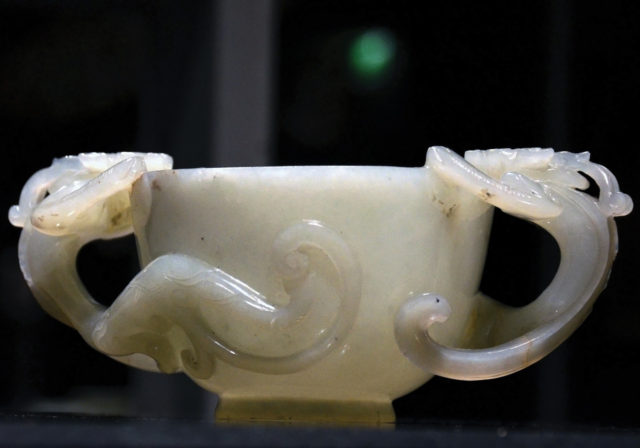Estimated reading time: 14 minutes
In the Western world, during Prehistoric times, jade was commonly used for tools and weapons and many of these objects have been preserved in Western collections. When it comes to adornment and jewels, however, the use of jade did not appear before the beginning of the 16th century and was related to the luxury goods trade routes controlled by the Portuguese in Asia and the Spaniards in Central America.
In China, the Portuguese settled first in Canton in 1517 and then in Macao in 1554. Portuguese merchants were the first to bring the pedra de ilharga to Europe. Sometime later, the Spaniards introduced Central American jade objects—piedra de hijada,—produced by civilizations such as the Mayans and Aztecs. Because of their apparent similarity, the two stones were mingled and called lapis nephreticus (kidney stone) in Europe, because it was believed helpful in soothing kidney pains. The French mineralogist Alexis Damour was the first
to distinguish the mineralogy of Chinese jade (nephrite) and American jade (jadeite) in 1863. The word “jade” is not scientific, it is related to the cultural ad trade.
In jewelry, jade was seldom used when compared to other gems in the Western world. Usually its use was motivated by the fascination for China, except in Russia with Fabergé.
Smuggled Chinese Jade
Historically, jade exports were forbidden by the Chinese although a few pieces were smuggled to Europe before China opened its borders following the Treaty of Nanking in 1842. By then, Chinoiserie was fashionable in European arts. It is a term from French that indicates the European fanciful interpretation and imitation of Chinese and East Asian arts in the 17th and 18th centuries. Chinese porcelain, lacquerware, cloisonné enamels and paintings were imported in large quantities from China, along with jade. Some jade pieces found their way to European courts such as this Mazarin jade cup in the 17th century.
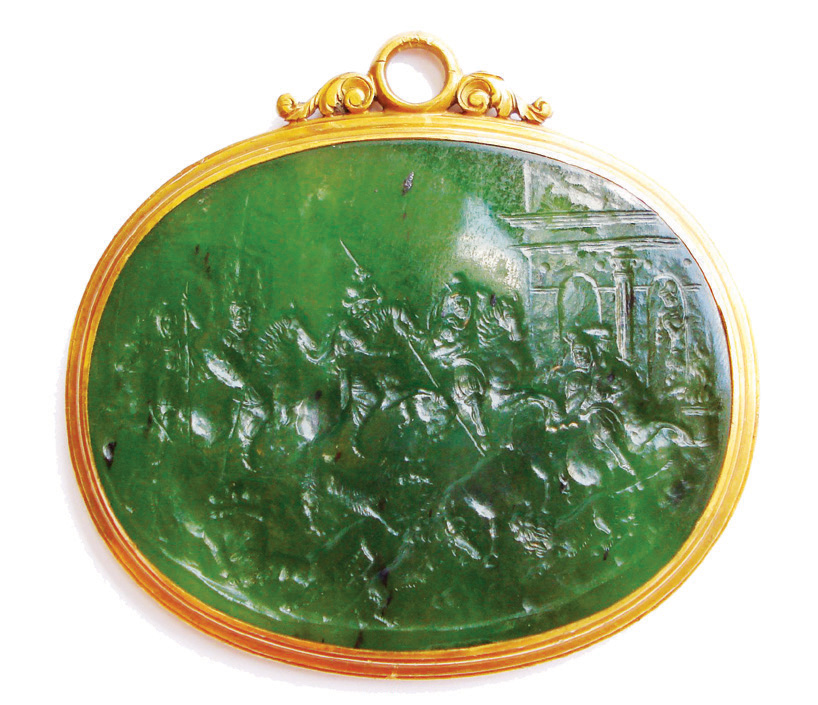
In jewelry, the 16th century intaglio attributed to the Italian glyptician Valerio Belli is among the rare preserved examples. It depicts a hunt scene with an architectural background, a fight between five horsemen holding spears with lions and dogs attacking bulls before them. The scene is carved on a piece of green nephrite, but so far, we don’t have any historic or scientific information related to its geographical origin.
Jade Stolen from the Summer Palace
The Empress Eugénie is at the origin of the creation of a Chinese Museum in the Château de Fontainebleau in 1863. She was a passionate collector of Far Eastern works of art. The main section of the Chinese collection was provided by thefts that happened during the looting of the Summer Palace (Yuanming yuan) in Beijing in October 1860, ordered by Lord Elgin in the Second Opium War.
After the victory of the French and the English, a large part of the most precious objects arrived in France in 1861.The pieces were sent to Fontainebleau to adorn the Chinese Museum of the Empress. Jades were a novelty under the Second Empire. Sixty-eight jades, among the most precious Chinese works of art, were showcased. Most belong to the Qing period (1644-1912), more precisely to the reign of Emperor Qianlong (1735-1796). Some pieces preserve their original Chinese labels indicating where they came from in the Summer Palace.
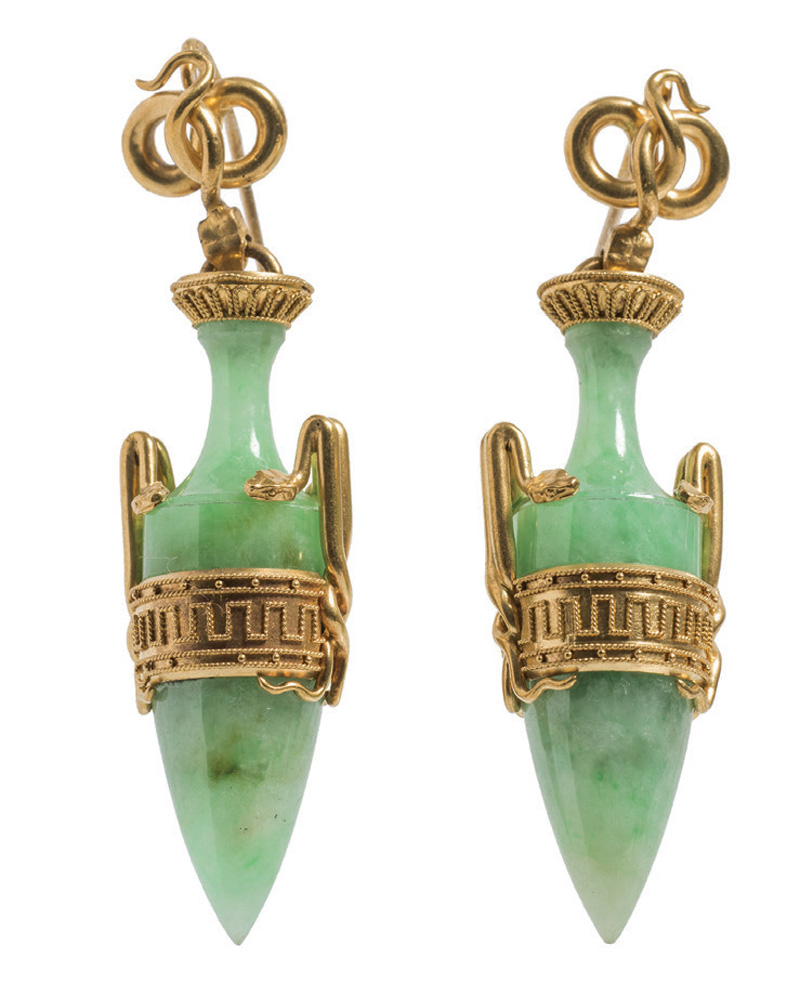
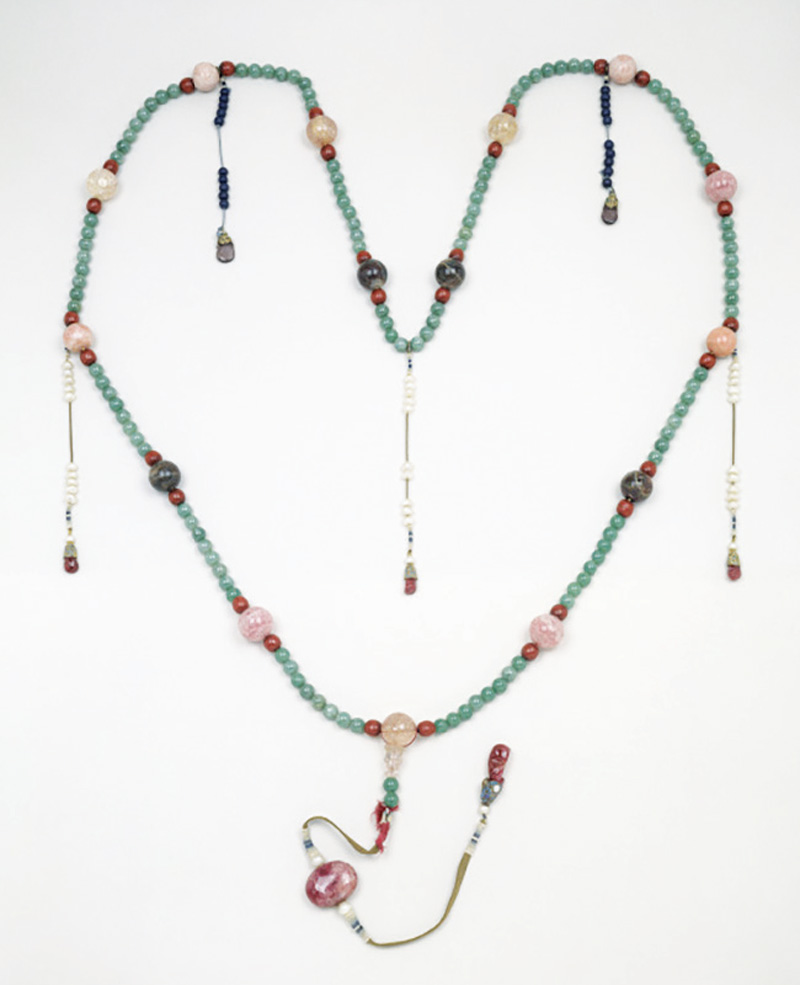
Despite the quality and the diversity of those jade pieces, only one would be famous during the Second Empire: The Empress Rosary. The General Cousin-Montauban, Commanderin- Chief of the French Expeditionary Force, assembled elements of three different mandarin necklaces from the Qing Dynasty in order to create a rosary for the prayerful Christian Empress. Mostly made of jadeite beads, it also contains coral, lapis-lazuli, tourmaline, spinel, quartz and pearls. This rosary became a symbol of the political dissension for the opposition newspapers opposed to the looting of the Summer Palace.
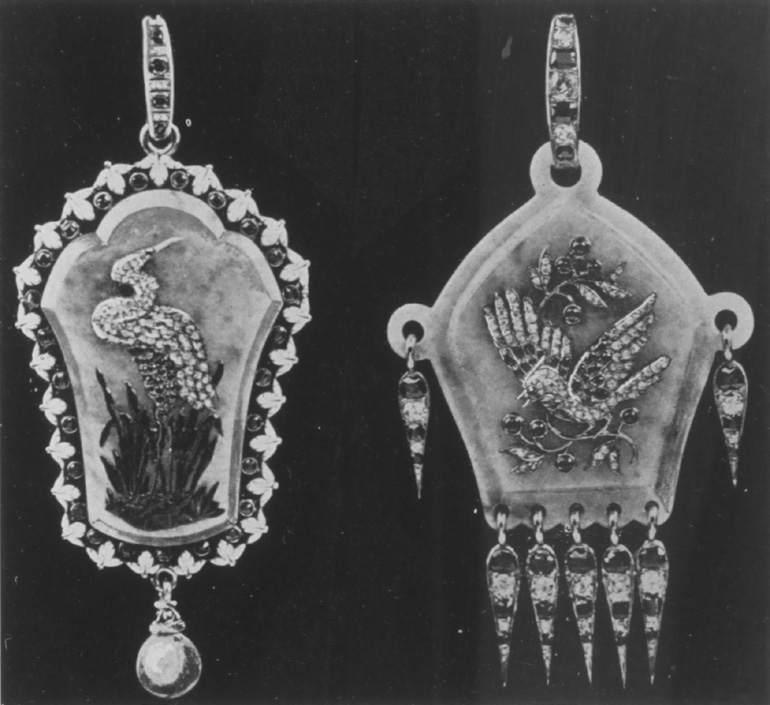
Henri Vever, in his history of French Jewelry of the Nineteenth Century, says that the first time jade was introduced into French jewelry was in the 1860s. In his book, he reproduces several pieces such as these two jadeite pendants in bird patterns. He states that the jadeite came from the looting of the Summer Palace.
Many of these jewels were made by Eugène Fontenay. A pair of earrings is on display in the Galerie des Bijoux at the MAD in Paris. Following the taste for eclecticism typical in the Second Empire, Fontenay mixed classical archaeological inspirations— the shape of the amphora ornamented with snake patterns and filigree—with jadeite, in reference to China.
The Jade of the Czars
Fabergé, the most famous Russian jeweler, used nephrite taken from boulders found along the Onot River in Siberia. He preferably used gems of Russian origin, mostly ornamental, and nephrite was among his favorites. It is probably the most frequent in his work. Many examples of delicately carved nephrite objects and jewels are preserved in museums and private collections. Fabergé used the gem to manufacture not only highly naturalistic charming animals or flower leaves, but also eggs, cups, boxes and frames, creating his own style without any reference to China.
Art Deco: The Golden Era for Jade in Western Jewelry
Except in Russia, jade was seldom used in European jewelry before the Art Deco era. In Paris, Chinese art became more accessible with the creation of the Musée Guimet in 1889 and the Musée Cernuschi in 1898. With his favorite designer Charles Jacqueau, Louis Cartier spent a lot of time in museums searching for inspiration. Oriental and Far Eastern arts were the essence of modernity to him. Cartier was a pioneer in Art Deco design and introduced jadeite as early as 1913 in a highly modern pendant-brooch.


The use of jade spread in the 1920s. It was the golden era for jade in Western jewelry. Artists and jewelers were inspired by exoticism and the Far East was the main inspirational source. After World War I, people needed to dream in the Roaring Twenties and were fascinated by Chinese art. In her recent publication about the French jeweler Lacloche, Laurence Mouillefarine explored the cultural background of the 1920s. According to French fashion magazines of the era, there was an obsession for China in all domains of taste. Parisian ladies began playing mahjong and adopting Pekinese dogs. Home decoration and fashion drew inspiration from Chinese art. Chinese-themed costume balls were very popular. People became crazy about jade. The firm Roger & Gallet launched a fragrance called Jade in a bottle shaped like a Chinese tobacco pouch. Dealers specializing in Asian art set up businesses in Paris. Trade-publication ads by Chinese antique dealer C. T. Loo offered “jade and hard stones –directly imported for jewelry.” Femina magazine considered jade a valuable gem.
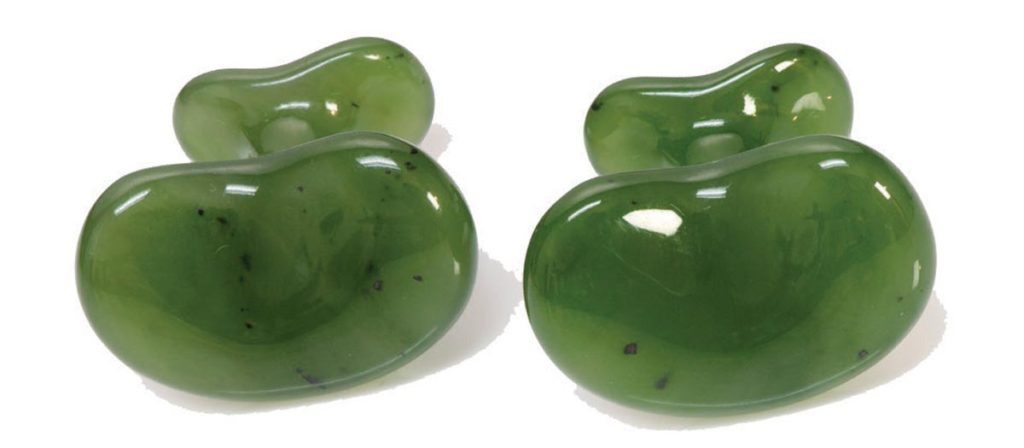
In its Christmas 1922 issue, it was mentioned among the most precious gems besides diamond, emerald, ruby and sapphire. The publication Le Grand Négoce remarked: “Jade has been used in France for the last few years, and its increasingly frequent adaptation for jewelry is owed entirely to the rarity of its hues, the most savored being the emerald shade.” This gem, which is difficult to carve and polish because of its hardness, gave rise to new displays of prowess by the lapidaries working for high jewelry.
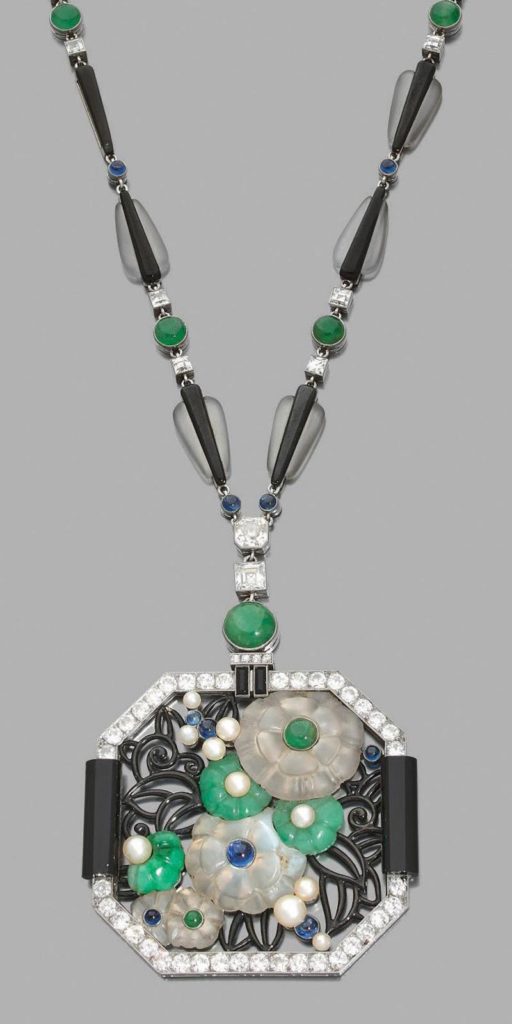
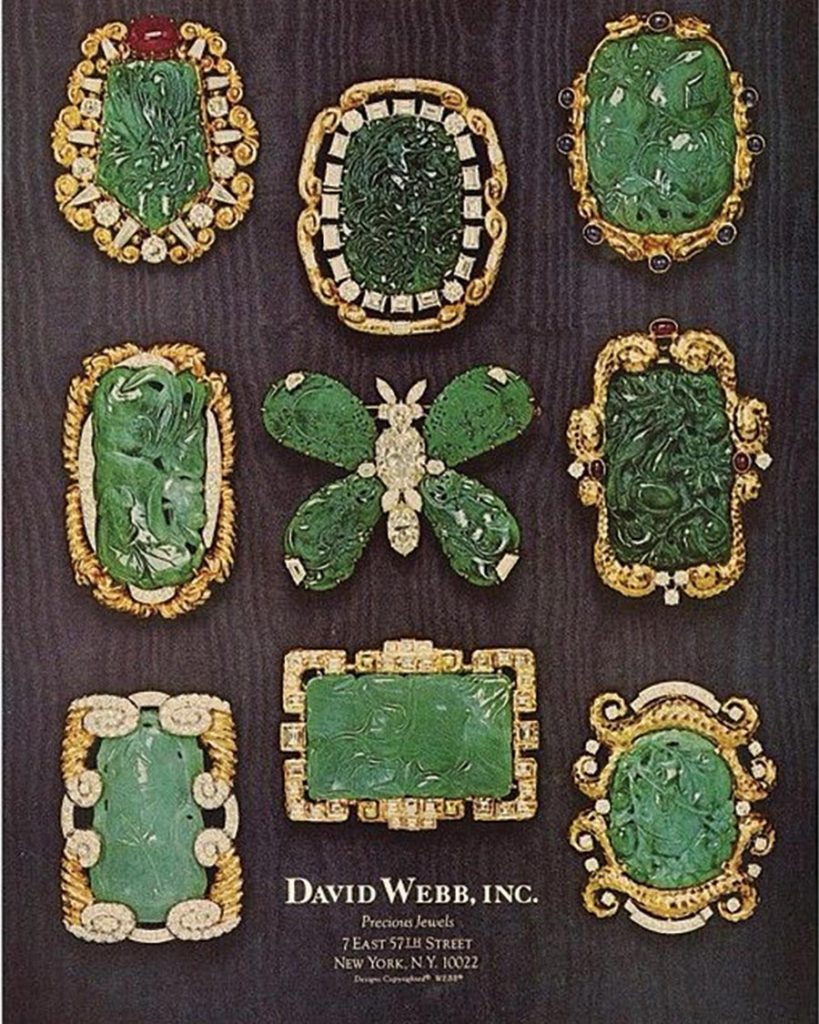
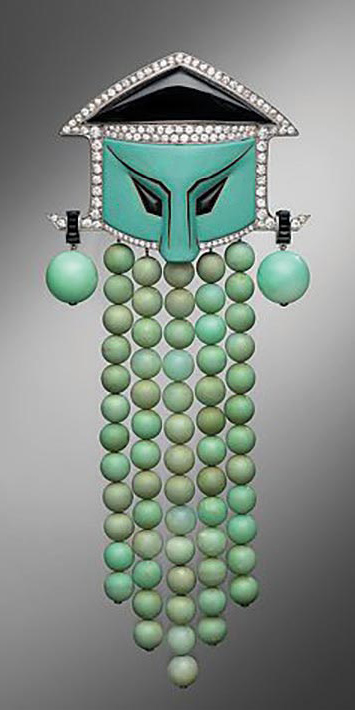
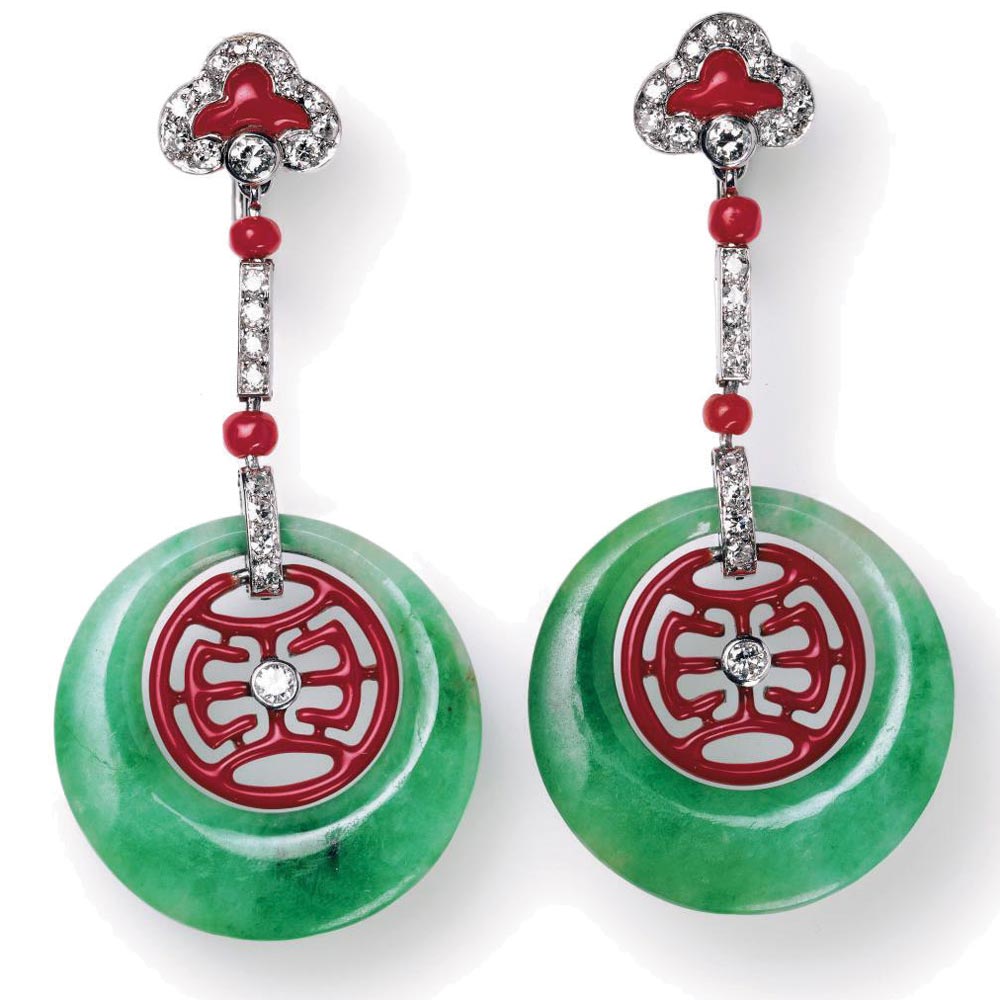
The use of jade is part of modern jewelry, honored in the boldest jewelry creations showcased at the Exposition des Arts Décoratifs et Industriels Modernes in 1925 (at the origin of the expression “Art Deco”). An excellent example is a stunning pendant by the Verger Frères for Lacloche, recently sold at auction in Paris.
Jade was particularly appreciated at Cartier. In one pair of earrings, the jeweler combines jadeite rings with the Chinese character for longevity in red enamel. According to Olivier Bachet, recognized Cartier expert, Cartier’s concerns were aesthetic and stylistic rather than symbolic. The main goal was to create in the Chinese style regardless of the signification of the Chinese motif. For Cartier, it meant using combinations of green and red colors.
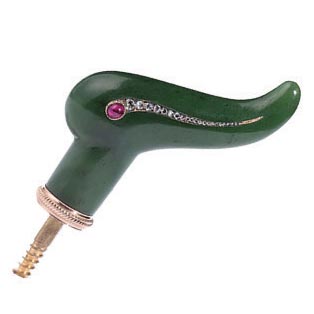
Cartier used also antique Chinese jade pieces to create modern jewels or precious objects. Many examples are preserved in the Cartier Collection, including jade hairpins turned into letter openers, jade snuffboxes that became perfume bottles, jade screens used in clocks, etc. These antique jades were part of the “stock des apprêts,” a collection of antique gems or objects of various origins chosen by Louis Cartier for their beauty and preserved in order to create new pieces.
American Taste for Jade in the 1970s
After the 1930s, jade was hardly used in Western jewelry. Interest in China returned in the 1970s, and jade was again in. Highly inspired by Art Deco jewelry, especially Cartier, the American jeweler David Webb produced many oversized pieces, including carved jade. Webb was known to buy old jade from antique shops in New York. Like Cartier, what he bought, he used. He had to accommodate the unique shapes by designing specific frames to contain the actual gems he worked with.
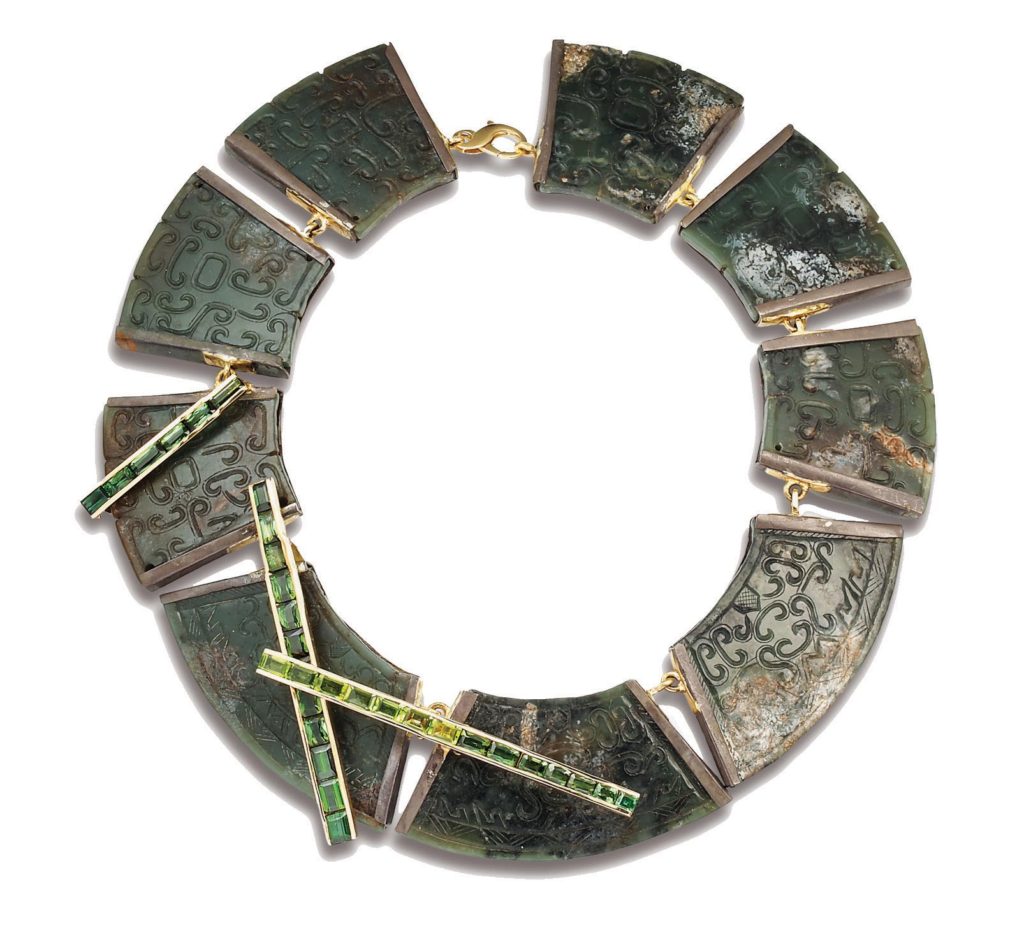
Jade was particularly appreciated in the U.S., even in collections. Great designers such as Elsa Peretti and Angela Cummings (who worked for Tiffany & Co. in the company in the 1970s and 1980s) introduced carved and polished nephrite in their boldest creations.
From Classicism to Modernity – 21st C Jewelers
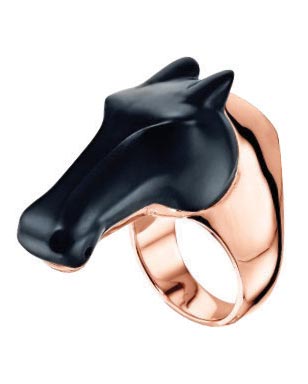
Since the beginning of the 21st century, jade came back as a discreet, but prestigious gem. It is the sign of a certain refinement and a taste for distinction. Like Cartier during the Art Deco period, the French jewelry artist Thierry Vendome was inspired by antique jade pieces. During a trip in Beijing in 2010, he bought a 19th century carved nephrite bi disc. In order to create the necklace’s joints, he sewed together it in several parts. Each was then set in silver and articulated by gold links. To create asymmetry, he applied three gold rods set with calibrated cut peridot and tourmaline in a green gradient.
Whether jadeite or nephrite, jewelers learned to appreciate the large range of colors, even when they are not uniform as seen in this JAR pendant on the left. Following the valuation criteria for jadeite, the green and purple cabochons are far from perfect, showing oxidization zones. But the jeweler was inspired by this mixing of colors and created a very refined combination of gemstones.
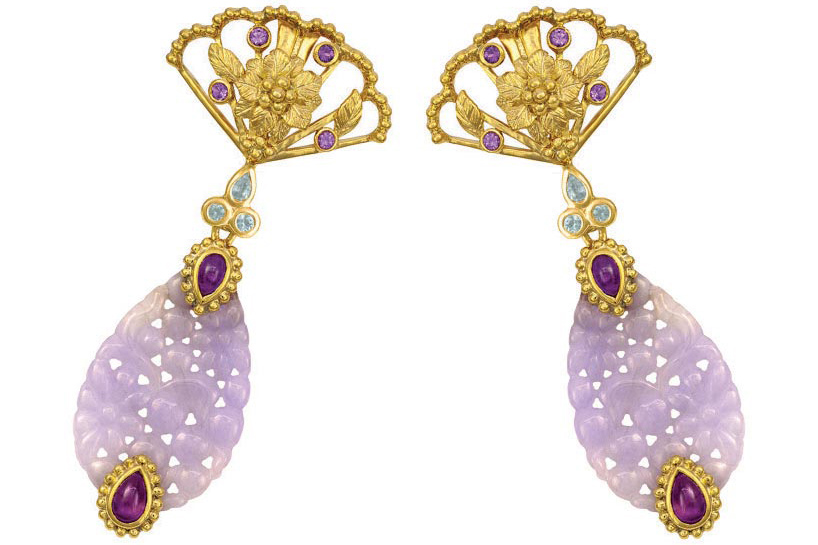
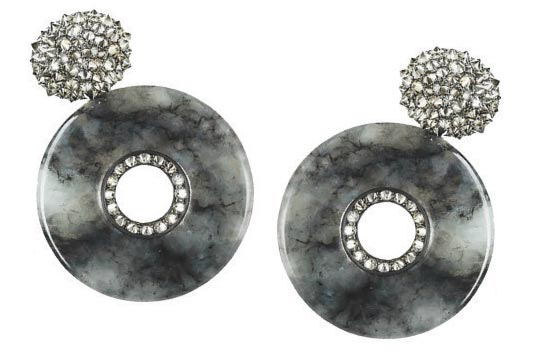
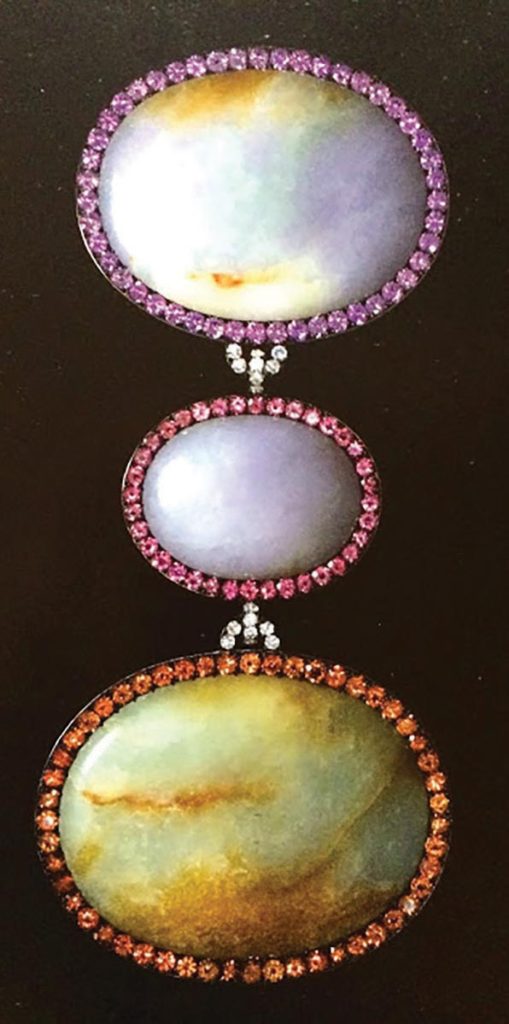
The German jeweler Hemmerle has been scouting jade’s potential for the last few years. Like JAR, he doesn’t look for perfection in the material. His criteria are different, basing his work on contrasts and chords between colors, textures and lusters. Hemmerle mingles green jadeite with demantoid garnet, rust jadeite with copper or mottled gray to black jadeite with upside down colorless diamonds set in silver in a gray gradient.
Today, jadeite and nephrite are not only related to the fantasy of China. These remarkable materials in terms of toughness and texture are appreciated for themselves. Western lapidaries learned to tame them in terms of carving, polishing and in their relation to light. Always in search of new materials, Hermès recently introduced black nephrite in high jewelry pieces. In its Galop ring, the horse’s head was carved and polished with a matt finish. Pierre Hardy, the designer, wanted it crafted as though it were leather. The contrast between the mirrorpolished gold and the velvety nephrite is brand new.
References
- Olivier Bachet & Alain Cartier, 2018, Cartier Exceptional Objects, Palais Royal.
- Pierre Bariand & Jean-Paul Poirot, 1985, Larousse des Pierres Précieuses, Larousse.
- Jade: From Emperors to Art Deco, 2016, MNAAG-Somogy.
- Laurence Mouillefarine & Véronique Ristelhueber, 2019, Lacloche Jewelers, Norma.
- Estelle Niklès Van Osselt, 2015, Asia imagined In the Baur and Cartier Collection, Yale University.
- Ruth Peltason, 2013, David Webb. The Quintessential American Jeweler, Assouline.
- Henri Vever, 2005, French Jewelry of the Nineteenth Century, ed. Katherine Purcell, Thames & Hudson.
- Wartski, 2006, Fabergé and the Russian Jewellers.



